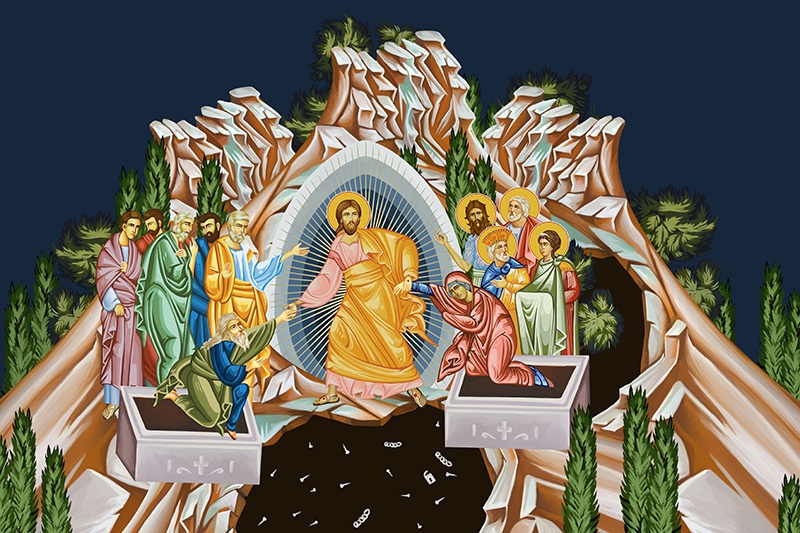During the Octave of Easter (the period from Easter Sunday to the following Sunday, inclusive), we get to hear a different Resurrection story every day. And why not? The Resurrection is a big, big deal—one of the most important events in history. Plus, these stories have something to say about our own destiny, since through baptism we expect to participate in the resurrection of the body someday.
By the way, if you have little kids, read each story on your own, then re-tell it, paraphrased, for your kids. They’ll love it, and you’ll notice details you would’ve missed in a straight reading.
As you read these stories, here are some things to watch for with your kids:
- What physical details are mentioned? This is a key point about the Resurrection: It was physical, not purely spiritual. Jesus was not a ghost, spirit, or apparition; he had a real (although transformed) body. What is that body like?
- When Jesus appears to his friends, how do they react? How would you react to such startling news?
- What does Jesus say to his disciples?
Want bonus points? Read the first reading for each day, too. Point out to your kids that throughout the Octave of Easter, the first reading describes how the disciples ultimately responded to the event of the Resurrection: It radically changed their lives, and drove them to proclaim the Good News to all people, even in the face of beatings and death threats. How does the news of the Resurrection change our lives? By the way, the simple, pithy proclamation of the Gospel that we hear in the speeches given by Peter and the other disciples is what the Church calls the kerygma. It provides a template or model for our own proclamation of the Gospel.
Here are the Resurrection stories, with links to the full text at the U.S. Catholic bishops’ website.
Sunday: A Race to the Tomb
There are three different options for the Gospel reading on Easter Sunday, but the one most often read features Mary Magdalene discovering the empty tomb. When she hurries back to tell the disciples about it, Peter and John race to the tomb…and because this is the Gospel of John, guess who wins? Peter ducks into the empty tomb first, though. What do they find?
Monday: ‘Do Not Be Afraid’
In this brief account, Mary Magdalene is accompanied by “the other Mary” at the tomb. On their way back to inform the disciples of the empty tomb, they encounter the resurrected Jesus himself, who tells them, “Do not be afraid.” Why would he say that? Also, we get a little story about how the Jewish religious leaders explained away the Resurrection during the earliest days of Christianity.
Tuesday: ‘Stop Holding Onto Me’
In this touching account, Mary Magdalene sits weeping outside the tomb when the resurrected Jesus appears to her. Strangely, she doesn’t immediately recognize him (a theme that is repeated in many of the Resurrection narratives). When she finally does recognize him, he says something strange to her: “Stop holding onto me, for I have not yet ascended to the Father.” What does that mean? This poignant scene became a favorite subject for artists. Search for art using the Latin phrase noli me tangere and you’ll find many different works from different periods to show your kids.
Wednesday: ‘Were Not Our Hearts Burning Within Us?’
This long story from the Gospel of Luke develops an incident that is only mentioned briefly in the Gospel of Mark. Two unnamed disciples are walking from Jerusalem to the small village of Emmaus on Easter Sunday. As they are walking, a stranger joins them. It’s Jesus, but once again the disciples fail to recognize him—even though the friendly stranger spends much of their journey spelling out to them how the death and resurrection of the messiah had been foretold by the prophets. Amusingly, when they reach their destination, Jesus pretends he’s going to keep going. It’s only when the disciples urge him to stay and he blesses and breaks the bread for their meal that they recognize who he really is. What does this say about the Eucharist we celebrate every Sunday?
Thursday: Not a Ghost
The reading for Thursday follows directly on the reading from Wednesday. The two disciples have rushed back from Emmaus (at night, no less!) to tell the other disciples about their encounter with Jesus (only to discover that Jesus has appeared to Peter, too). While they’re still talking, Jesus appears to them. Strangely, the disciples are terrified, thinking he’s a ghost. Jesus demonstrates that he has “flesh and bones” by eating some fish. What does this tell us about our own resurrected bodies? What does this imply about the dignity of the bodies we have now?
Friday: Breakfast by the Sea
The Gospel of John provides us with another beautifully detailed account of Jesus’ third appearance to the disciples, this time at the break of dawn after the disciples have spent the night fishing. Again, the disciples do not immediately recognize Jesus until he does something to tip his hand—in this case, producing a miraculous catch of fish. And once again, Jesus shares bread and fish with the disciples, echoing the importance of the meals they had shared during his earthly ministry—and the sacred meal the Church continues to share in the Eucharist. What’s your favorite detail from this account?
Saturday: ‘They Did Not Believe’
As is his style, Mark provides us with three short, quick accounts of encounters with the Resurrection. What stands out in this passage is the disciples’ reaction to the news—not once, but twice, they respond to news of the Resurrection with disbelief. It is only when Jesus appears to them while they are eating that they finally believe. What does Jesus tell the disciples (and us) to do?
Sunday: Doubting Thomas (and a Little Pentecost)
The focus of this Resurrection account is typically the disbelief of Thomas, but there’s something else interesting going on here. When he first appears to them, Jesus breathes on them and says, “Receive the Holy Spirit.” Scripture scholars often call this passage John’s version of Pentecost, the descent of the Holy Spirit on the Church. (The more familiar account is found at the beginning of the Acts of the Disciples.) Compare this account to another account of the divine breath: In Genesis 2:7, where God breaths on Adam to give him life. What authority do the disciples receive with the Holy Spirit?



